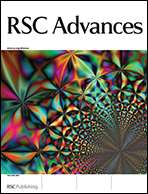Mussel inspired modification of carbon nanotubes using RAFT derived stimuli-responsive polymers†
Abstract
A novel strategy for surface modification of multi-walled carbon nanotubes (MWCNTs) using reversible addition fragmentation transfer (RAFT) derived pH- and thermo-responsive polymers was developed via a combination of mussel inspired chemistry and a Michael addition reaction. In this procedure, pristine MWCNTs were first coated with polydopamine through self polymerization of dopamine under alkine solution, and then RAFT derived stimuli-responsive polymers were further grafted onto PDA modified MWCNTs via a Michael addition reaction. The successful modification of MWCNTs was confirmed by a series of characterization techniques including transmission electron microscopy, Fourier transform infrared spectroscopy, Raman spectroscopy, thermal gravimetric analysis and X-ray photoelectron spectrometry. These polymer modified CNTs showed enhanced dispersibility in various solutions and pH-/temperature-responsive properties. Due to the strong adhesion of polydopamine to various materials surface, the method described in this work could also be extended to the surface modification of other nanomaterials.


 Please wait while we load your content...
Please wait while we load your content...